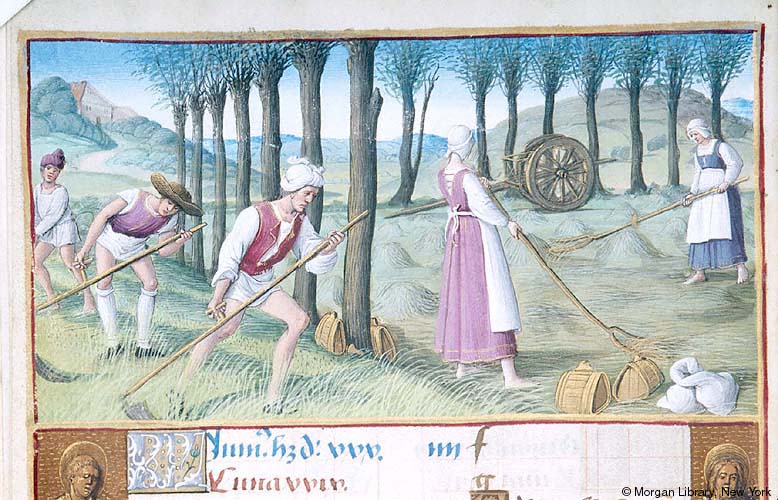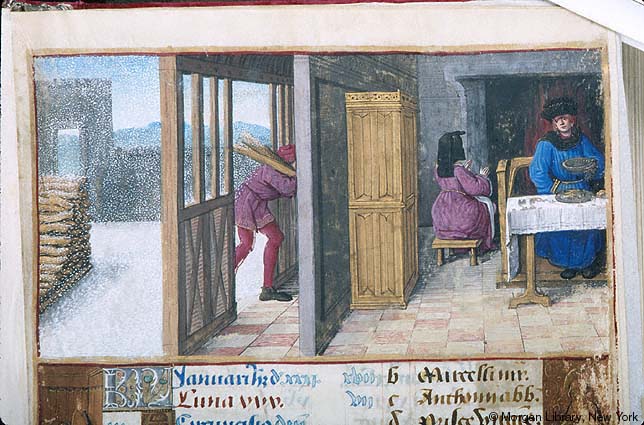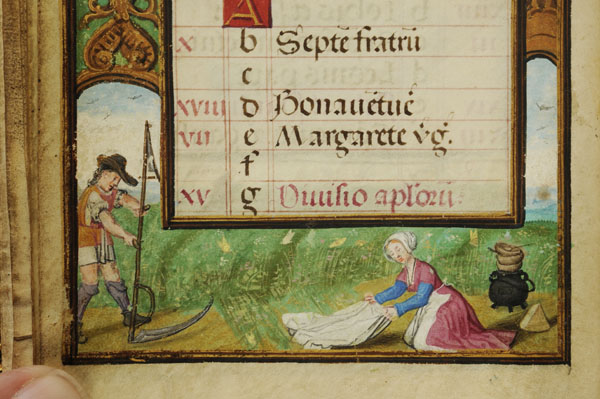Objectives/Research Questions
- What kind of aprons appear in period artwork? Are they half aprons (covering from the waist down), aprons with bibs (over the bodice), or a mixture?
- What shape do the apron 'skirts' take (rectangle, rounded, half-circle)?
- How full are the aprons? How is this handled at the waist (attached smoothly, gathered, gauged)?
- What is the waistband made of (tapes, cord, fabric)?
- How is the apron fastened (ties, cord, buttons)?
Paintings and Illustrations
These are my main sources of information, particularly occupational/genre paintings showing working people. With thanks to several artists named Pieter, and all the meticulous limners producing Books of Hours in the early 16th century. And everyone who scanned them!
Brugel's Prudence includes at least two women and one men wearing half-aprons [click link for larger image]. The women's waistbands are hidden by their arms, but we can see that the top corners of both aprons are fluttering free, not attached to the waistband. It's not certain that the center is sewn to the waistband versus being tucked into it, but whatever the form of attachment is, its occurring at the top center of the apron 'skirt'.
| Prudence (1559) by Pieter Bruegel the Elder |
Bruegel's paintings give more apron-wearing figures, and in color. In The Peasant Dance, we see a child wearing a blue/green half-apron that covers the front and sides of her skirt. Beside her, a woman wears a white half-apron, with either a black waistband or a black belt over the waistband; the corners for the white apron are loose, and appear to almost meet in the back, while a purse hangs from the waistband/belt over the apron:
| Detail from Bruegel's The Peasant Dance (c.1567). Via The Atheneum. |
| Detail from Bruegel's The Peasant Dance (c.1567). Via The Atheneum. |
| Wedding Dance in the Open Air (1566) Via The Atheneum. |
Brugel's Children's Games, shows more of these half aprons with free corners, as well as two possible bibbed aprons. Two of the green half-aprons:
| Detail from Children's Games by Pieter Bruegel the Elder (1560) From The Atheneum. |
| Detail from Children's Games by Pieter Bruegel the Elder (1560) From The Atheneum. |
Pieter Aertsen's paintings show blue and white aprons much like Bruegel's. Again, most of the figures as posed in ways that obscure the waistbands:
| The Fat Kitchen: An Allegory by Pieter Aertsen From The Atheneum |
Aertsen's 1563 A Kitchen Scene has a child wearing a white half-apron, and an adult woman possibly wearing a white bibbed apron with a belt over it. Another long, white, rectangular half-apron appears on a background figure in Market Scene (1560-1565), and more half-aprons in the background of Peasants By the Hearth (1560).
Aertsen's two paintings of female cooks show some better apron detail. In the one, the cook's dark apron has free-hanging corners, and a narrow band around the waist continues past the apron skirt. In the other, the front apron material is bunched, as though under tension, and the apron itself clearly has no waistband visible at the center front. It's possible that this apron doesn't have a waistband all around, but instead has ties or a partial waistband connected to the skirt piece, and extending around the back (this could be true for both aprons--we don't see both front and back on any one figure).
| The Cook (c.1559) by Pieter Aertsen From The Atheneum |
Cook in Front of the Stove (1559) by Pieter Aertsen
From The Atheneum.
|
Aertsen's The Pancake Bakery (1560) has a brown apron which also appears to have this top-front wrinkling and no visible waistband; it also has a blue version of the Bruegel probably-bibbed-apron, this time worn by an elderly woman. For more Aertsen apron-fun, see Market Woman (1567); Farmer's Feast (1550) has both women and men wearing aprons, with one of the latter wearing his tied in front. Preparations for a Feast (c.1550-1575), shows two women working in a kitchen wearing ruffs: the woman in the foreground has a gathered apron, with a fairly narrow tape or fabric waistband, with the woman in the background also has a relatively wide fabric or tape waistband:
| Preparations for a Feast (c.1550-1575) by Pieter Aertsen From The Atheneum. |
 |
| Detail of haymakers (June) in the Hours of Henry VIII. From the Morgan Library and Museum. |
The January page also shows a woman wearing an apron. Only a faint white line is visible for the waistband, suggesting a narrow tape or cord. Although the woman's back is almost fully to the viewer, no bow is visible. If not a neglected detail, this may suggest an apron tied in front.
 |
| Detail of woman before a fire (January) in the Book of Hours of Henry VIII. From the Morgan Library and Museum. |
 |
| The Annunciation, from the Book of Hours of Henry VIII. From the Morgan Library and Museum. |
In the Bruges Book of Hours, we get more white, rectangular half aprons. The milkmaid in the foreground of April, again, has an obscured waist, but her apron appears to be put on with some fullness, resulting in a series of vertical lines/pleats down the front.
 |
| Detail of milkmaids (April), the Bruges Book of Hours From the Morgan Library and Museum |
July's laundress has an apron with a very narrow waistband (tape or cord), which may be tied behind her. Like the Bruegel and Aertsen paintings, this apron has loose front corners: taken together with the others, I suspect we're seeing an apron where the lower portion sewn flat to a narrow waistband at the center front (though it's not impossible that we're seeing a separate piece of cloth only tucked in at the center or with two attached ties making an incomplete waistband).
 | |
|
 |
| Commerce, from a Parisian Book of Hours, c.1511-1520 The Morgan Library and Museum. |
A few more very narrow waistbands. This one from Lucas Cranach the Elder appears to have a contrasting waistband. I had considered the possibility of a belt worn over the apron, but given how many of these have shown up without any particular evidence for a belt (other that waistband being different from the lower apron), I suspect it's just a two-color apron.
 |
| Detail from Old Man Beguiled by Courtesans by Lucas Cranach the Elder c.1537 |
 |
| Detail from Netherlandish Proverbs by Pieter Bruegel the Elder, c. 1559 |
 |
| Detail from Portrait of A Lady Spinning by van Heemskerck c. 1531 |
An original Italian apron, unfinished, is trapezoidal in shape and has no waistband. (I love the marking on the upper right for the incomplete drawn-work)! The VAM has a late (1580-1600) 16th century English apron: it, too, is apparently unfinished. This rectangular, white, linen half-apron was decorated with embroidery, cutwork, and lace edging. [Edited to add: more detailed measurements and pictures are available here. The band is described as a linen tape.]
Conclusions
It's possible that some of these aprons were in two pieces: a rectangular cloth tucked in or folded over a narrow band at the waist. The shape of these aprons seems to always be rectangular, though one trapezoidal example was found (unfinished). In some cases, only the center top edge is secured at the waist, leaving the corners to dangle. In other cases (the woman on the right in the detail from Netherlandish Proverbs), the dangling corners may actually be the bottom corner of the apron thrown up towards the waist; in others (such as the two children from Children's Games), the corners are clearly the upper corners of the apron, which are not attached to the waistband.
The paintings show both white and colored (blue, green, brown) aprons, with white dominating in the manuscript illuminations. The Tudor Tailor mentions black, white, blue and green aprons appearing in text sources.
Note: I was looking at women's aprons here, but several of the books of hours show men wearing aprons to work (as do Brugel's paintings). Even Jesus gets a white apron in one Book of Hours.
The Tudor Child has some information on aprons, although it (obviously) is geared more towards children. Without rooting to find my copy, I recall that they mention pleated aprons were more for elite children, and the flat, creased aprons with the outer quarters hanging free from the waistbands were for middling and lower classes. Bibs were also separate and pinned on.
ReplyDeleteThanks! I'll have to check that out. I just finally got to read The Queen's Servants, and enjoyed it immensely.
ReplyDelete